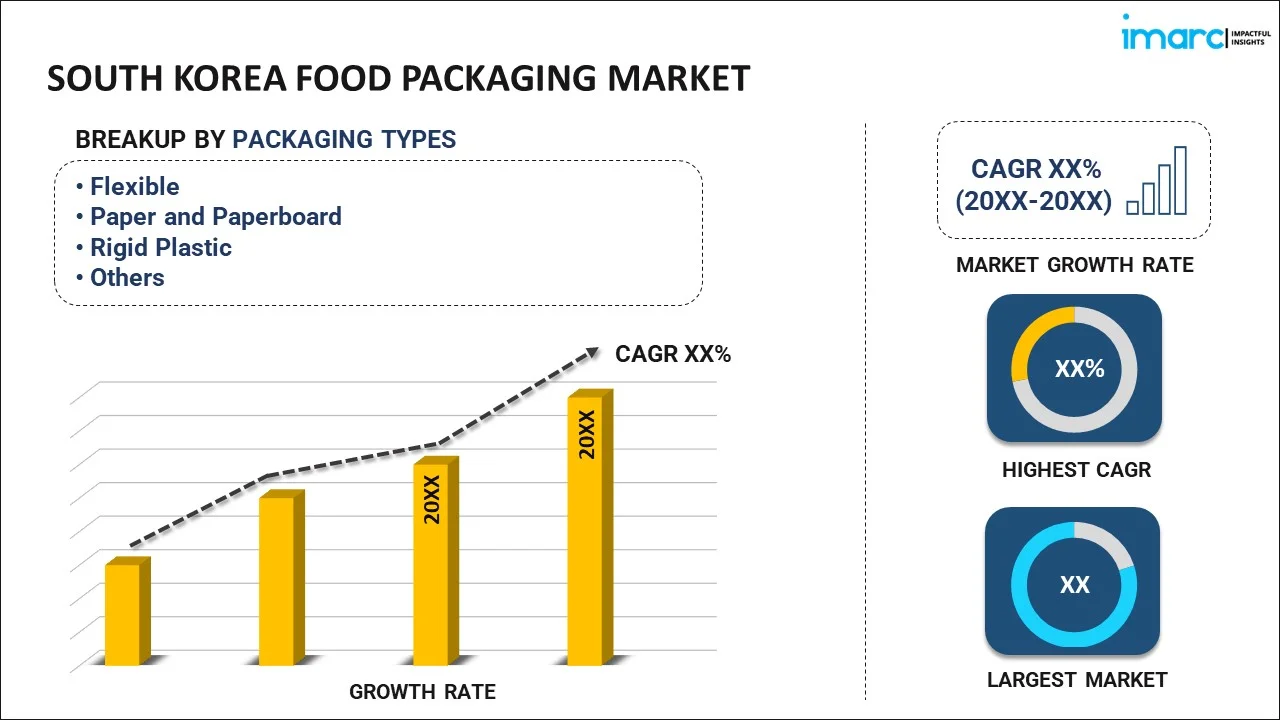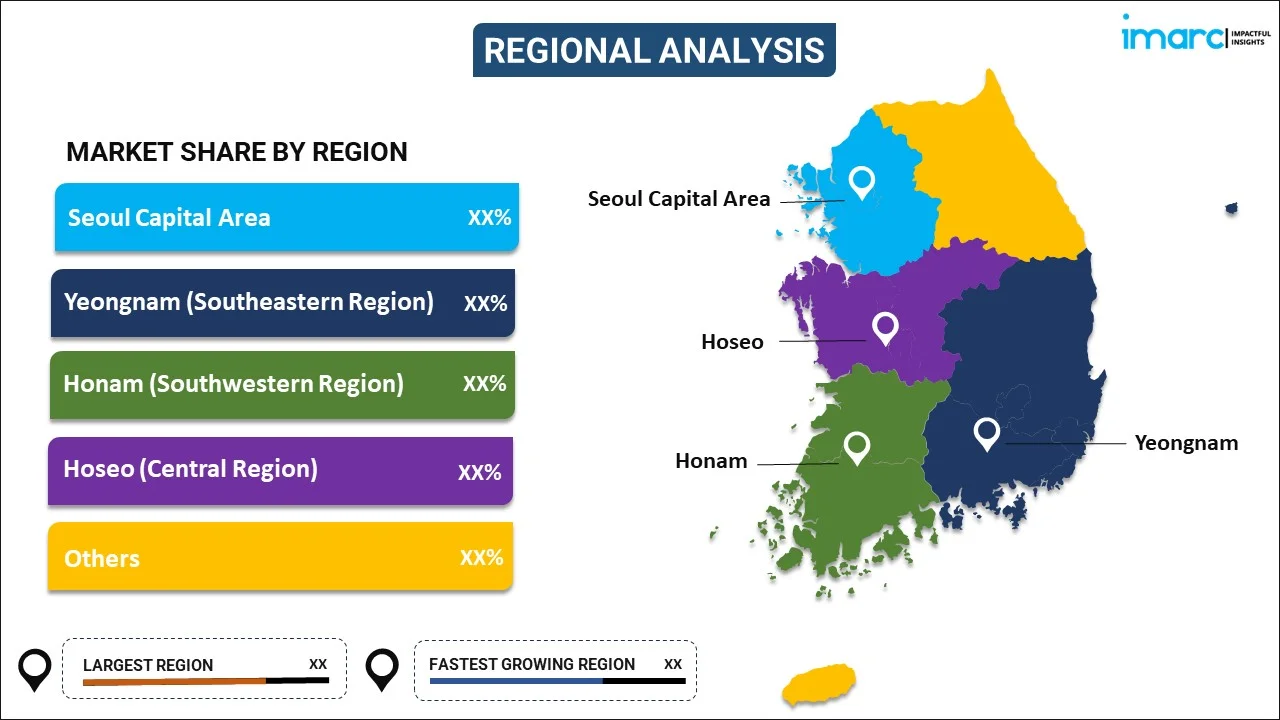
South Korea Food Packaging Market Report by Packaging Type (Flexible, Paper and Paperboard, Rigid Plastic, Glass, Metal, and Others), Application (Bakery, Confectionary, Pasta, and Noodles, Dairy Products, Sauces, Dressings, and Condiments, Snacks and Side Dishes, Convenience Foods, Meat, Fish, and Poultry, Fruits and Vegetables, and Others), and Region 2024-2032
Market Overview:
South Korea food packaging market size is projected to exhibit a growth rate (CAGR) of 4.36% during 2024-2032. The escalating demand for portion-controlled packaging and easy-to-open designs, rising preferences of individuals for packaging that can protect against contamination and tampering, and the increasing awareness among the masses about health and wellness represent some of the key factors driving the market.
|
Report Attribute
|
Key Statistics
|
|---|---|
|
Base Year
|
2023 |
|
Forecast Years
|
2024-2032
|
|
Historical Years
|
2018-2023
|
| Market Growth Rate (2024-2032) | 4.36% |
Food packaging is used to enclose and protect food products, ensuring their safety, preservation, and presentation. It acts as a barrier against external factors, such as moisture, light, and oxygen, thereby safeguarding the quality and safety of the contents. It extends the shelf life of food products by minimizing exposure to microorganisms and maintaining optimal storage conditions. It provides essential information, including product name, ingredients, nutritional facts, and expiration date, enabling individuals to make informed choices. It enhances convenience for consumers through easy opening, re-sealability, and portion control features. It offers convenience through portion control, easy storage, and on-the-go consumption. It aids in preserving the integrity and safety of processed foods, including frozen foods, snacks, and beverages. It is also used in pharmaceutical products, ensuring the safety and efficacy of medicines.
South Korea Food Packaging Market Trends:
Rapid urbanization and busy lifestyles of individuals are catalyzing the demand for convenience and ready-to-eat (RTE) food products. This is driving the need for efficient and innovative food packaging solutions in South Korea. Additionally, changing dietary preferences and food consumption patterns of individuals and the escalating demand for portion-controlled packaging and easy-to-open designs are facilitating the market growth. Along with this, the growing concerns about food safety are driving the demand for packaging that ensures the integrity and freshness of products. Furthermore, rising preferences of individuals for packaging that can protect against contamination and tampering are strengthening the growth of the market. In line with this, the growth of online grocery shopping and food delivery services is offering a favorable market outlook. E-commerce requires robust packaging solutions that can withstand the rigors of shipping and ensure food products arrive in pristine condition. Moreover, the increasing awareness among the masses about health and wellness is catalyzing the demand for packaging that supports portion control, preserves nutritional value, and provides clear labeling of ingredients and nutritional information. In addition, the widespread adoption of smart packaging solutions to provide people with product information, recipes, and interactive experiences is influencing the market positively. Besides this, the development of packaging solutions with convenience features, such as resealable zippers, easy-open tabs, and microwave-safe containers, is attracting a wider consumer base. Moreover, several brands are offering customization options, which is creating a more intimate and engaging experience. Furthermore, several South Korean companies are exploring innovative packaging materials, including edible packaging, which can reduce waste and offer unique consumer experiences. Along with this, governing authorities of the country are taking various measures to ensure the safety and quality of packaging materials. They are also implementing regulations related to labeling, food contact materials, and environmental sustainability.
South Korea Food Packaging Market Segmentation:
IMARC Group provides an analysis of the key trends in each segment of the market, along with forecasts at the country level for 2024-2032. Our report has categorized the market based on packaging type and application.
Packaging Type Insights:

- Flexible
- Paper and Paperboard
- Rigid Plastic
- Glass
- Metal
- Others
The report has provided a detailed breakup and analysis of the market based on the packaging type. This includes flexible, paper and paperboard, rigid plastic, glass, metal, and others.
Application Insights:
- Bakery, Confectionary, Pasta, and Noodles
- Dairy Products
- Sauces, Dressings, and Condiments
- Snacks and Side Dishes
- Convenience Foods
- Meat, Fish, and Poultry
- Fruits and Vegetables
- Others
A detailed breakup and analysis of the market based on the application have also been provided in the report. This includes bakery, confectionary, pasta, and noodles, dairy products, sauces, dressings, and condiments, snacks and side dishes, convenience foods, meat, fish, and poultry, fruits and vegetables, and others.
Regional Insights:

- Seoul Capital Area
- Yeongnam (Southeastern Region)
- Honam (Southwestern Region)
- Hoseo (Central Region)
- Others
The report has also provided a comprehensive analysis of all the major regional markets, which include Seoul Capital Area, Yeongnam (Southeastern Region), Honam (Southwestern Region), Hoseo (Central Region) and Others.
Competitive Landscape:
The market research report has also provided a comprehensive analysis of the competitive landscape. Competitive analysis such as market structure, key player positioning, top winning strategies, competitive dashboard, and company evaluation quadrant has been covered in the report. Also, detailed profiles of all major companies have been provided.
South Korea Food Packaging Market Report Coverage:
| Report Features | Details |
|---|---|
| Base Year of the Analysis | 2023 |
| Historical Period | 2018-2023 |
| Forecast Period | 2024-2032 |
| Units | US$ Million |
| Scope of the Report | Exploration of Historical and Forecast Trends, Industry Catalysts and Challenges, Segment-Wise Historical and Predictive Market Assessment:
|
| Packaging Types Covered | Flexible, Paper and Paperboard, Rigid Plastic, Glass, Metal, Others |
| Applications Covered | Bakery, Confectionary, Pasta, and Noodles, Dairy Products, Sauces, Dressings, and Condiments, Snacks and Side Dishes, Convenience Foods, Meat, Fish, and Poultry, Fruits and Vegetables, Others |
| Regions Covered | Seoul Capital Area, Yeongnam (Southeastern Region), Honam (Southwestern Region), Hoseo (Central Region), Others |
| Customization Scope | 10% Free Customization |
| Report Price and Purchase Option | Single User License: US$ 3699 Five User License: US$ 4699 Corporate License: US$ 5699 |
| Post-Sale Analyst Support | 10-12 Weeks |
| Delivery Format | PDF and Excel through Email (We can also provide the editable version of the report in PPT/Word format on special request) |
Key Questions Answered in This Report:
- How has the South Korea food packaging market performed so far and how will it perform in the coming years?
- What has been the impact of COVID-19 on the South Korea food packaging market?
- What is the breakup of the South Korea food packaging market on the basis of packaging type?
- What is the breakup of the South Korea food packaging market on the basis of application?
- What are the various stages in the value chain of the South Korea food packaging market?
- What are the key driving factors and challenges in the South Korea food packaging?
- What is the structure of the South Korea food packaging market and who are the key players?
- What is the degree of competition in the South Korea food packaging market?
Key Benefits for Stakeholders:
- IMARC’s industry report offers a comprehensive quantitative analysis of various market segments, historical and current market trends, market forecasts, and dynamics of the South Korea food packaging market from 2018-2032.
- The research report provides the latest information on the market drivers, challenges, and opportunities in the South Korea food packaging market.
- Porter's five forces analysis assist stakeholders in assessing the impact of new entrants, competitive rivalry, supplier power, buyer power, and the threat of substitution. It helps stakeholders to analyze the level of competition within the South Korea food packaging industry and its attractiveness.
- Competitive landscape allows stakeholders to understand their competitive environment and provides an insight into the current positions of key players in the market.
Need more help?
- Speak to our experienced analysts for insights on the current market scenarios.
- Include additional segments and countries to customize the report as per your requirement.
- Gain an unparalleled competitive advantage in your domain by understanding how to utilize the report and positively impacting your operations and revenue.
- For further assistance, please connect with our analysts.
 Inquire Before Buying
Inquire Before Buying
 Speak to an Analyst
Speak to an Analyst
 Request Brochure
Request Brochure
 Request Customization
Request Customization




.webp)




.webp)












